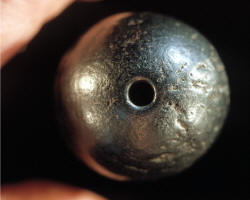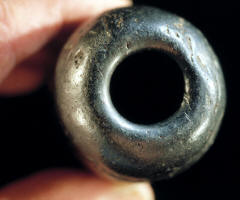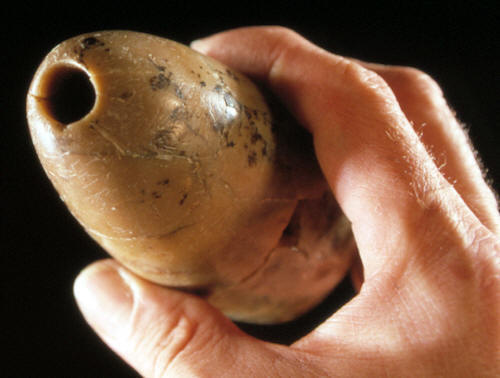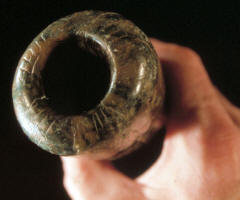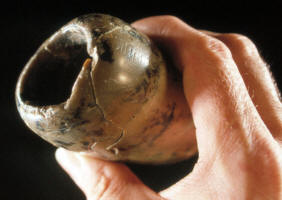|
|
|
Only one of the tube pipes from the Coal Draw cache in Wyoming was found intact, all the others are described as having been ritually broken. Evidence shows that the three steatite pipes illustrated in this article were probably broken while still inside their pipe bag because all the pieces were found very close together. Many of the missing pipe fragments have not been recovered because a thorough excavation would involve the removal of large blocks of sandstone weighing several tons. One of the pipes in the cache is represented by only one fragment. The other pipe described in this article, from northern Indiana, was found unbroken and in perfect condition. |
|
|
|
|
The Coal Draw site pipes were made from several different materials. Some of the materials are not found locally. Half of the total group of twelve pipes from Wyoming are made of steatite. The other pipes were made of sandstone, serpentinite, one is described as a white talc-like material, one is described as a light bluish material with black inclusions and another is described as an unidentified soft material. The pipe from northern Indiana is made of canal coal. All the pipes were made from softer stones that could be carved. |
|
|
It would be difficult, if not impossible, to positively identify any particular tube pipe as ever having been used in a healing procedure by sucking or blowing. But since early accounts do describe sucking tubes made of stone we know that some were used for this purpose. Several observations do suggest reasons why the pipes from the Coal Draw site may have been particularly special objects and used in this way. But the main reasons are that none of the pipes show any signs of ever having been smoked, no residue could be found. Plus, one of the pipes was partially packed with red ochre. Special attention was also taken to make sure the pipes were "killed" or broken (except for one example) so no one else could ever use them again. Some of the pipes were engraved with mysterious looking animals and other shapes. The largest pipe has bird-like figures engraved on it. Their smooth rounded ends also would make very efficient sucking instruments. The pipe from northern Indiana has very smooth and rounded ends. It also does not show any signs of ever having been smoked. |
|
|
The four pipes illustrated here are very well crafted. They were made from various types of reasonably soft carvable stone by grinding, polishing, drilling and scraping. Some of the stones are also particularly colorful. What is apparent with all of the pipes illustrated here is that they were important items to the individuals who once owned them. They were used so much that some of the engraved lines on at least one example was worn smooth. We may never know for sure, but the primitive stone tools described here may have been used in countless healing ceremonies by a respected medicine man or shaman----someone who could communicate between the physical and the spirit world. |
|
|
"REFERENCES"
1899, Mc.Guire, Joseph D., "Pipes and Smoking
Customs of the American Aborigines, Based on Material in the U.S.
National Museum," Report of the U.S. National Museum, Part I, pp.
383, 386-387 & 390. |
|

